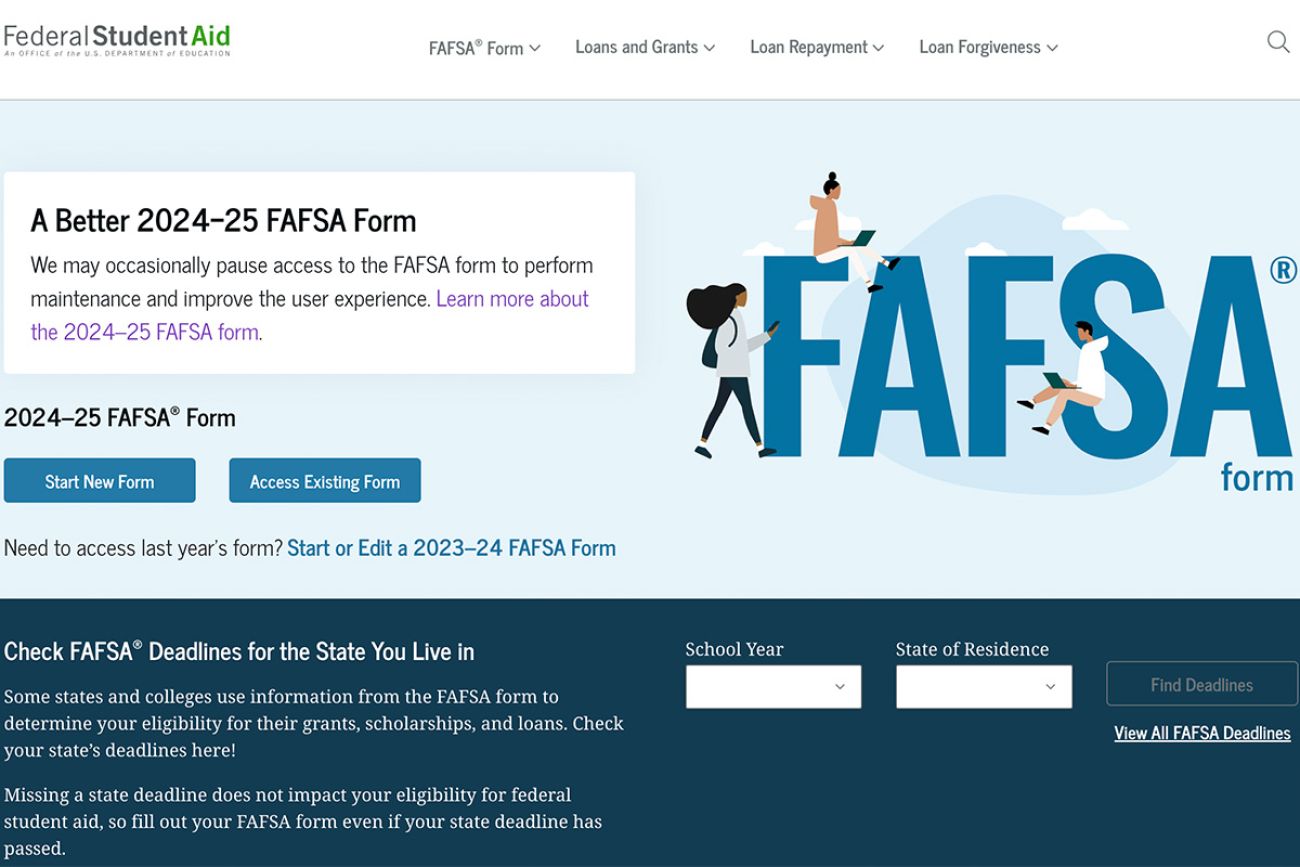How delays in college financial aid offers will affect Michigan students

- Potential college students will have to wait longer to get financial aid offers from schools due to FAFSA delay
- College financial aid administrators urge patience as they wait for financial information from the federal government
- Students and their families had to wait longer this cycle to fill out the federal form for student aid
Michigan high school seniors will have to wait longer to get financial aid offers from colleges this year, adding stress to an already stressful process.
The U.S. Department of Education said Tuesday it will not send student financial information to schools until the “first half of March,” weeks later than expected. Colleges and universities had previously been told they would start receiving this information at the end of January.
The Free Application for Federal Student Aid (FAFSA) is a form that potential and current college students fill out with their financial information to qualify for need-based scholarships and grants. Colleges, universities, trade schools and states use the information to distribute funds from school, state and federal programs that help students with tuition and other college expenses.
Related:
- New FAFSA form: What MI students need to know about 2024-2025 application
- Whitmer to push for free community college tuition at State of the State
- Michigan spread word on free college. But are residents listening?
In previous years, Michigan universities typically received the financial information about three days after students submitted their FAFSA form to the government, which could be as early as October, said Dan Hurley, the Chief Executive Officer of the Michigan Association of State Universities. Colleges typically start making financial offers between mid-December and late January.
This year, however, an effort to make the form simpler and expand the number of students who qualify for aid has led to challenges. The form’s rollout was delayed and some people still cannot complete the form.
The delay in the federal government sending the financial information to colleges is the latest in a series of hold ups and hiccups around the financial aid process for students.
The FAFSA form affects funds that students aren’t required to pay back, such as grants, scholarships and work-study programs, as well as student loans. In Michigan, the FAFSA is a key form for several state aid programs.
Without the student data from the FAFSA, many colleges and universities cannot provide potential and current students with crucial information about how much they’ll have to pay for school, making it more difficult for students to make decisions about their future and creating additional stress.
“I’m just holding on for this thing to come back to me to tell me what I do next to pay her bill next year,” said Vicki Wilson, a retired school principal and current education consultant who filled out the FAFSA earlier this month with her 18-year-old daughter.
Wilson’s daughter has committed to attending Michigan State University in the fall, but Wilson said she is still waiting to see if her daughter will qualify for loans, scholarships and grants.
It costs about $27,800 a year for an undergraduate student’s tuition, fees and housing at MSU, but many students pay less with the help of scholarships, grants and loans.
Many colleges and universities typically require students to commit by May 1. If financial aid offers don’t arrive until April, students who need financial aid to afford college will have very little time to make life-changing decisions about where to enroll, said Sarah Kasabian-Larson, director of scholarships and financial aid at Central Michigan University.
“This definitely changes a lot for students,” she said.
I filled out the FAFSA. What does this delay mean for me?
Michigan students are still getting acceptance letters on the same timeline as past years, but they won’t get information on whether they qualify for some grants, scholarships and loans until later.
For example, at CMU, students are told whether or not they qualify for merit scholarships when they get their acceptance letter. But applicants won’t find out about federal and state aid until they get their financial aid letters.
“We were hoping to get offers out in early March, but obviously now we can’t do that until we start receiving the FAFSA data so now we’re hoping for early April,” Kasabian-Larson said.
At Northwestern Michigan College, a community college in Traverse City, Director of Financial Aid Linda Berlin anticipates students will receive financial aid offers in April and May.
Alyssa Fredin, Director of Financial Aid at Michigan Technological University, said MTU “is hoping to send financial aid letters to incoming students by mid-April, but there is a lot that goes into getting those letters out.”
The school will have to be fluid and may have to adjust its timeline as more information arrives.
There is a different process for the Ann Arbor campus of the University of Michigan. Incoming students must submit both a FAFSA and a CSS Profile, a different financial form to help students receive non-federal student aid.
Tammie Durham Luis, assistant vice provost for enrollment management and executive director of financial aid at U-M, said the school will use the data in the CSS Profile to develop financial aid packages.
“Admitted undergraduate students, who have submitted the CSS Profile, will continue to receive their estimated financial aid package approximately two weeks after receiving their admissions decision, which is our typical window for these students.”
I haven’t filled out the FAFSA. Am I too late?
No. College financial aid experts recommend students and fill out the FAFSA.
“You can’t know if college is affordable for your family unless you have your financial aid letters and you can't get an award letter unless you fill out a FAFSA,” said Colby Cesaro, vice president of Michigan Independent Colleges and Universities association.
I’m a student waiting on my financial aid information. What should I do?
College financial aid experts are urging students and parents to be patient.
Still, students can get some sense of what they will be expected to pay. Ryan Fewins-Bliss, executive director of the Michigan College Access Network, a group that works to increase college access particularly for low-income students, students of color and students who are the first in their families to go to college, recommends using the Federal Student Aid Estimator to determine potential aid and then comparing actual college costs using a net price calculator, which estimates the yearly college cost after scholarships and grants are factored in
When students fill out the FAFSA, they receive a confirmation notice that tells them whether they should expect to qualify for federal Pell grants. They’ll also receive a predicted Student Aid Index number, which is a tool schools use to determine how much federal student aid a student qualifies for.
Cesaro, of the independent college and university group, recommends that students communicate their estimated Student Aid Index number with schools while they’re waiting for financial aid news but not all colleges recommend that step.
Chad Sanders, communications manager for MSU’s Office of Financial Aid, does not recommend potential students send student aid index or grant eligibility information directly to MSU.
Fredin, of Michigan Tech, recommends students complete visits, apply for school and community scholarships and make a list of non-financial reasons they would like to attend each school.
“This will ensure they are prepared to make their final decision quickly once financial aid letters are received,” she said.
I have more questions about the FAFSA. Where should I go?
Individual colleges and universities have web pages with updates on the FAFSA process and financial aid offices are available to answer questions.
Bridge Michigan has a guide to filling out the FAFSA here.
The Student Aid website includes information on how to complete the form, a help page with answers to common questions and videos to help with the FAFSA process. You can also live chat, email or call the Federal Student Aid Information Center and talk to a virtual assistant named Aidan.
Michigan Education Watch
Michigan Education Watch is made possible by generous financial support from:
Subscribe to Michigan Education Watch
See what new members are saying about why they donated to Bridge Michigan:
- “In order for this information to be accurate and unbiased it must be underwritten by its readers, not by special interests.” - Larry S.
- “Not many other media sources report on the topics Bridge does.” - Susan B.
- “Your journalism is outstanding and rare these days.” - Mark S.
If you want to ensure the future of nonpartisan, nonprofit Michigan journalism, please become a member today. You, too, will be asked why you donated and maybe we'll feature your quote next time!






